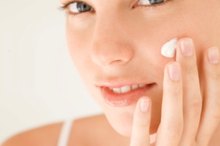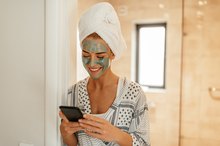10 Steps of a Spa Facial
While each spa has its own treatment protocols, certain features are common in most professional facials. Meant to cleanse, improve and pamper your skin, spa facials relax and rejuvenate.
Cleanse
Your esthetician will begin your facial by removing any makeup. Once your skin is bare, she will massage cleansing milk -- or cream, gel or lotion -- into your face, neck and décolleté. Using facial sponges, cloths or cotton pads, she will remove the cleanser with warm water and pat your skin dry 2.
Consultation
How to Clean Nose Pores
Learn More
Your eyes will be covered with moistened pads for the next step. Using a lighted magnifying glass, she will evaluate your skin. She may lightly pinch your skin to check for elasticity or press on it to check thickness. During this phase, your esthetician may discuss her findings with you and ask you about your skin care regimen and your expectations for the facial 2.
- Your eyes will be covered with moistened pads for the next step.
- During this phase, your esthetician may discuss her findings with you and ask you about your skin care regimen and your expectations for the facial 2.
Exfoliation
Now that your esthetician understands your skin care needs, she will choose an exfoliation cream, gel, mask, gommage or peel to use. Certain exfoliation products, such as enzyme peels, require the product to be left on your face to dissolve the plugs that cause blackheads. Other products require either manual or machine stimulation.
Steam
How to Get Rid of Deep Clogged Pores
Learn More
Depending upon the exfoliation product used, steam will either be applied to your face during that phase or after the product has been removed. Some spas may use heated, moist towels instead of steam. The moist heat loosens plugs and encourages skin to sweat out any impurities that may be caught in pores.
Extraction
During the extraction phase, your esthetician will remove blackheads and, possibly, whiteheads. Usually, she will use a lighted magnifying glass to examine your skin. Your esthetician may use a blackhead extractor, a stainless steel instrument that allows blackheads to be gently expressed. Some estheticians choose to wrap their fingers with cotton to protect your skin while manually expressing the plugs.
- During the extraction phase, your esthetician will remove blackheads and, possibly, whiteheads.
- Your esthetician may use a blackhead extractor, a stainless steel instrument that allows blackheads to be gently expressed.
Massage
Facial massage stimulates and lubricates skin 2. Your esthetician may use a massage oil or lotion during this process. Depending upon her training and the treatment, she may massage your neck, shoulders, décolleté and/or scalp as well. You may notice that your sinuses feel clearer and that you feel deeply relaxed after the massage.
- Facial massage stimulates and lubricates skin 2.
- Depending upon her training and the treatment, she may massage your neck, shoulders, décolleté and/or scalp as well.
Mask
Depending upon your skin’s needs, your esthetician will choose a mask for you. If your skin is oily, she may choose a clay-based mask to draw off the excessive sebum. If your skin is dehydrated, she’ll choose one that replenishes moisture. Masks are highly specific and are formulated to treat specific skin care needs.
- Depending upon your skin’s needs, your esthetician will choose a mask for you.
- If your skin is dehydrated, she’ll choose one that replenishes moisture.
More Massage
For the 10 minutes or so that you wear the mask, your esthetician may perform a massage on your hands and arms, your feet and calves and/or your scalp.
Serum
After your mask is removed, your esthetician will likely apply a specialty serum to your skin. Some spas charge extra for this step, while others include it as part of the facial. Serums include those for aging skin, for blemished skin and for sensitive skin.
Final Touches
Before sending you out the door, your esthetician will apply a skin-specific cream or gel to your skin. She may also apply an eye gel and/or lip treatment cream.
Related Articles
References
- Massage and Bodywork Magazine: Fountain of Youth
- Skin Inc.: The Art of the Facial Massage
- Smart Skin Care: Basic Steps of Facial Skin Care Routine: Cleansing
- Lees, M. Clearing Concepts: A Guide to Acne Treatment. Chicago, IL: Cengage Learning; 2013.
- Pfenninger, JL, Fowler, GC. Pfenninger and Fowler's Procedures for Primary Care. New York, NY: Elsevier Health Sciences; 2010.
- Hall, C. 8 dermatologist-recommended face masks for beating acne. Elle Magazine. Updated January 2, 2019.
- Craven, H. Face toners and astringents: which product and ingredients are best for my skin. dermcollective. Updated July 15, 2019.
- "Questions and Answers About Acne." National Institute of Arthritis and Musculoskeletal and Skin Diseases (NIAMS). Jan 2006. National Institutes of Health.
- Zaenglein AL, Pathy AL, Schlosser BJ, Alikhan A, Baldwid HE, Berson D, et. al. "Guidelines of Care for the Management of Acne Vulgaris." Journal of the American Academy of Dermatology. 2016;74(5):945-973.
- Gerson, Joel; Ph.D.. Standard Textbook for Professional Estheticians. 8th edition. Albany, NY: Milady Publishing, 1999.
- Titus S, Hodge J. “Diagnosis and treatment of acne.” American Family Physician. 2012 Oct 15; 86(8):734-40.
Writer Bio
Katherine Mariaca is a professional freelance journalist who specializes in alternative and complementary medicine, and skin and body care treatments. A longtime spa director and VP of skin care companies, Mariaca developed products and services for the spa industry. She earned a B.S. from Tufts and an M.F.A. from Lesley.








